Wildlife Health Victoria

Wildlife Health Victoria: Surveillance, investigates sick and dead wildlife from free ranging populations of endemic mammals, birds, reptiles and amphibians in Victoria to understand baseline wildlife health patterns, detect changes and factors involved, and understand wildlife reservoirs of zoonotic diseases. We are seeking people in Victoria interested in wildlife health to assist.
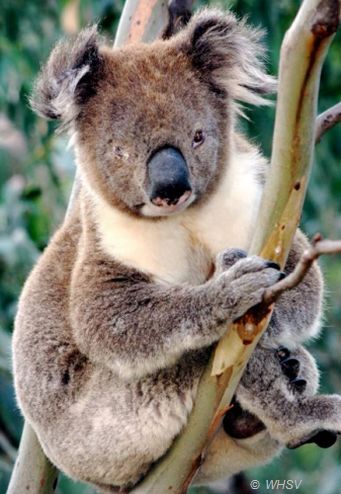
How you can help
Monitoring
You can monitor the health of local free ranging populations, record these, and report your observations to Wildlife Health Victoria: Surveillance. (Information is used only for wildlife health.) e.g. you observe a flock of 10 Crimson Rosellas several times a week. Use binoculars to check health. Signs of health problems include: fluffed up, thin, weak, feather problems, material around eyes or nose etc. In a notebook record the species, number of affected birds, record the signs of disease you observe, and the number of healthy animals.
We are interested in the rates of disease: the number sick compared to total number of that species you see. e.g. 1 weak, thin rosella, 9 normal.
Please phone Pam Whiteley to discuss this 0400 119 301, or email Pam Whiteley with your contact details if you wish to contribute.
Online survey
Take part in the online survey about sarcoptic mange in wildlife in Victoria, starting 12 June 2019.
Survey of sarcoptic mange of wildlife in Victoria
Reporting
Please report any freshly dead wildlife for possible necropsy (post-mortem) investigation.
Report sick and dead wildlife from free ranging populations in Victoria.
We are particularly interested in investigating koalas and parrots, cockatoos and lorikeets following a survey we did 2008-09. We are also interested in platypus carcasses for investigation.
If you find freshly dead wildlife wrap a strong plastic bag around it without touching it, pick and tie it up, then a second plastic bag, then a third to ensure no leaks, and hold in a disposable box in the shade with ice, away from pets and children. Wash your hands and use an antiseptic rinse.
Record the species, date, location, signs of disease, number of animals and your contact details.
Phone 0400 119 301 or e-mail Pam Whiteley
Observations
Eastern Grey Kangaroos and Wallabies
Report to (0400 119 301) if you see:
- Sub-adults that are dead or weak due to an intestinal blood sucking worm Globocephaloides trifidospicularis in the small intestine can be found where there is a high density of Eastern Grey Kangaroos. We wish to necropsy carcasses to make a diagnosis.
- The last animal in the mob to move away is incoordinated and may fall over.
- Kangaroos with lumps on their legs. They may have difficulty moving.
- Incoordinated, wobbly or apparent blindness macropods can be due to Kangaroo Blindness Virus, phalaris staggers from pasture, toxoplasmosis from cat faeces etc.
- Eye and nasal discharge, sneezing and tail twitching. Herpes virus has been identified.
- Kangaroos with skin lump on their legs, suspect pox virus lumps (see image), they may have difficulty moving.
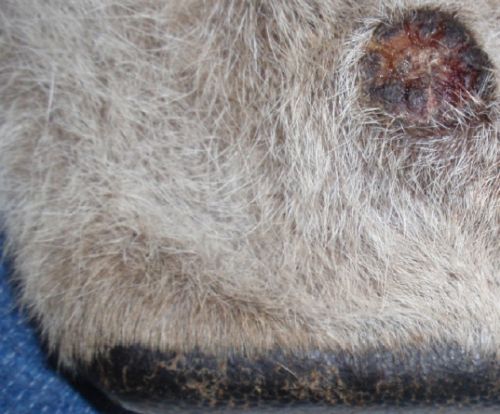
Observe Parrot & Cockatoos
- Beak and feather disease (circovirus), Chlamydia psittaci bacteria etc.
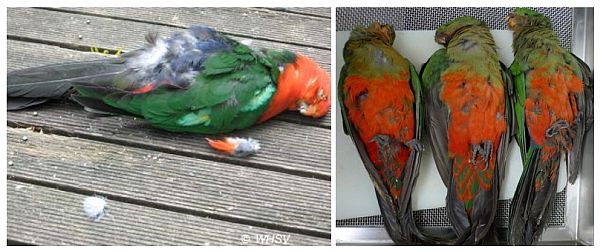
King Parrots - Morbidity and mortality during winter, possibly due to intestinal protozoa Spironucleosis ssp.
Crimson Rosellas - Morbidity and mortality during winter.
Long-billed Corellas - Morbidity and mortality was reported and Chlamydophila spp. detected.
Observe Ravens - Ravens with skin lumps, suspect pox virus.
Observe Koalas
- Mange, scurfy skin above feet, on sternum and face.
- Kidney disease; send clin-path reports of urine and blood.
- Deaths; Chlamydophila spp have been detected.
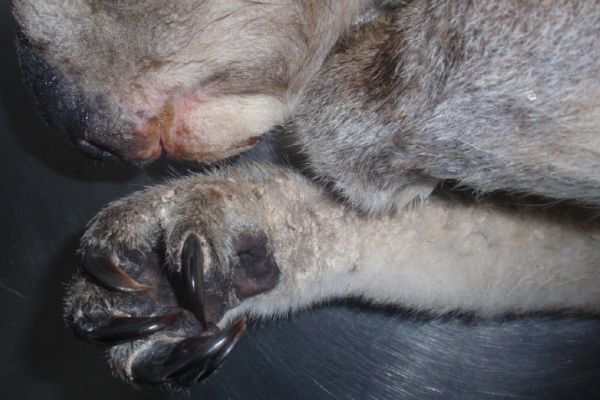
Koala with crusty skin due to Sarcoptes scabiei mites, sarcoptic mange.
Observe Platypus
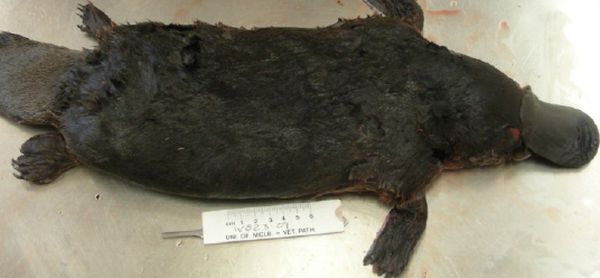
Observe Frogs
- Growling Grass Frogs & Pobblebonk, positive for Chytrid fungus.
Observe Reptiles

Wildlife Serum
- Arboviruses antibodies; please collect serum from all wildlife, including waterbirds (especially herons and cormorants etc.) for Murray Valley encephalitis etc.
- Collect dead nestlings for examination.
- Small volumes of blood can be collected onto filter paper – contact Pam Whiteley.
Contact
Pam Whiteley BVSc MS MANZCVS BTeach ACCM
Mobile: 0400 119 301
Email: Pam Whiteley
Or Dave Hobbs 0448475279 or Histopath 97312000
Dead wildlife can be transported to Werribee overnight for investigation
Faculty of Veterinary and Agricultural Sciences,
The University of Melbourne
Wildlife Health Victoria: Surveillance
250 Princes Highway
Werribee VIC 3030
Online survey
Take part in the online survey about sarcoptic mange in wildlife in Victoria, starting 12 June 2019.
Survey of sarcoptic mange of wildlife in Victoria


